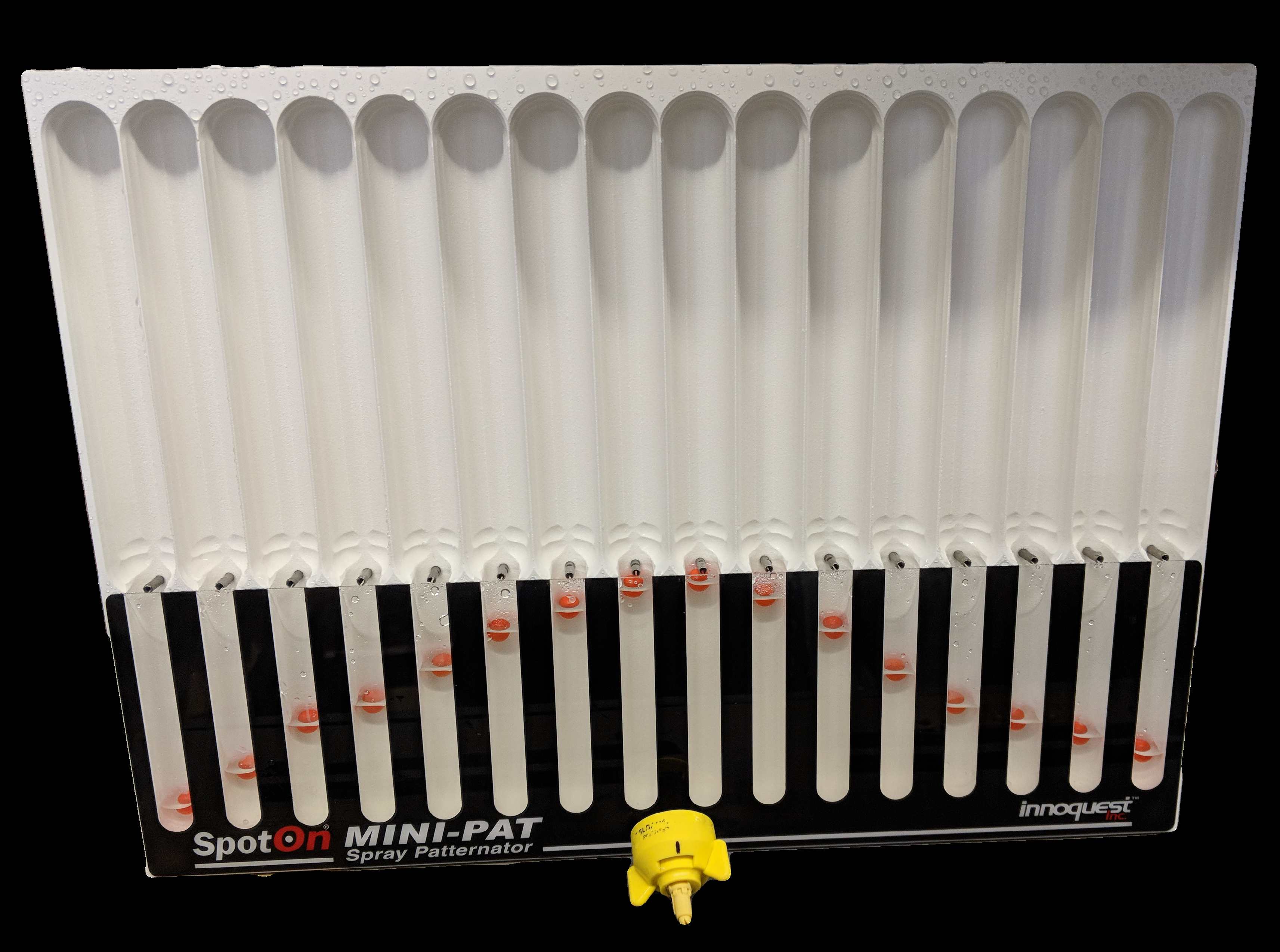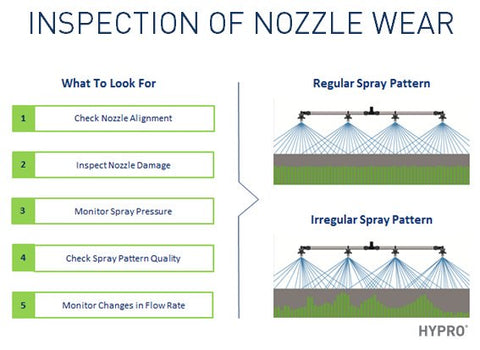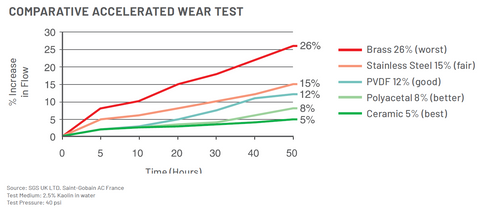Your cart is empty

How Long Do Spray Nozzles Last?
How long do spray nozzles last?
This is one of the most common questions the Nozzle Ninja gets asked. A simple answer would create more nozzle sales, unfortunately there isn't a hard fast rule as to how much product can be applied by a nozzle before it needs to be replaced. If you are asking yourself the question "Are these nozzles still good" then likely it is time to replace them.
There are several factors that affect nozzle wear. Simple flow and visual diagnostic tests can be used to determine that the time is right to replace a set of nozzles. Before I drag you into the epic excitement of nozzle materials, design, and testing here are some quick tips on nozzle life span.
- As a % cost of your sprayer operations, nozzles are the most cost effective and affordable tools to improve your application quality.
- Consider checking nozzle flow each season or after about 10,000ac of use
- Nozzle Ninja has tested identical nozzles that have shown 10% wear after just 14,000 acres of use on one sprayer and the same model of nozzles that still performed well having covered 55,000 acres on another sprayer
- Inspect nozzles for both flow and pattern distribution. This is essential with Pre-orifice nozzles.
- Visually inspect nozzle patterns daily.
- Nozzle lights can help show irregularities from wear or physical damage to nozzles from accidental tillage and forestry operations (it happens to even the best operators)
- Keep a log of how many acres you spray with each nozzle size
- Spraying at Higher Pressures will cause nozzles to wear faster than lower pressures
- The abrasiveness of the solution sprayed and water quality will change nozzle life
- For easy testing with no calculations use a testing device or Nozzle Ninja's Nozzle Testing Service
- A hand held patternator is a valuable tool in determining the health of nozzles with a measuring pre-orifice and exit orifice as flow may not accurately determine their health
- A Boom section remote control is also an excellent tool for checking nozzles
- A pressure gauge right at the nozzle is also essential to proper hand calibration as well as as a calibration jug.
To learn more about how nozzle material and design affect nozzle life and how wear should be tested keep on reading. If you are breaking out into a cold sweat while calculating the acres you put through your favourite set of nozzles proceed directly to our Air Induction and Non Air induction nozzle catalogues
When diagnosing nozzle health how the nozzle meters and distributes solution should be considered. Many nozzle designs have more than one orifice which means more than one wear point. Some nozzles that create an angled spray can even have an additional wear point if the exit orifice is used to deflect spray at an angle.
Pre-Orifice-Controls the volume of product entering the mixing chamber, generally speaking shows less wear than exit orifice. Volume measurement catch tests will show if this orifice is worn as nozzle output will increase given the same fluid pressure.
Exit/pattern Creation Orifice- Can be subject to physical damage and generally speaking shows wear sooner than the pre-orifice. If the nozzle has a single orifice a volume measurement should give a good indication of nozzle health. If the nozzle has a pre-orifice it is necessary to visually inspect the pattern distribution or use a patternator to ensure that the exit orifice is not worn and creating uneven distribution.
Nozzle Material
Nozzles are made out of many different materials. Some nozzles may even have two or three different materials used to create the nozzle housing and orifices. There is a common belief that Stainless Steel will have better wear resistance vs. a plastic nozzle. This is not the case. One of the most common materials used to produce nozzles is polyacetyl or the Dupont equivalent Delrin. Nozzles made from polyacetal/Delrin materials will last longer than stainless steel nozzles. Chemical compatibility must also be considered, but when purchasing nozzles the right material can provide much longer life.
Ceramic – Highly resistant to abrasive and corrosive chemistry and provides superior wear resistance in abrasive applications and high pressures.
ADI LDC, AVI All have Ceramic Orifices
Polyacetal/Delrin – Provides good resistance to most chemicals and superior wear resistance to most agricultural chemistry. Susceptible to strong mineral acids and a few organic solvents. Resistance to most alkalis is excellent. Organic solvents usually cause slight swelling without any other harmful effect. This is the material of choice for most agricultural broadcast Nozzles.
Polyvinylidene Fluoride (PVDF) – Should be used with acid-based agricultural defoliation chemistry. Good resistance to wear.*Resists many reagents and high temperatures (up to 300°F). Susceptible to high temperatures above water boiling (210°F) in combination with concentrated sulfuric and nitric acids. Preferred in industrial spraying applications.
Stainless Steel –Good resistance to chemicals and provides average wear resistance.
Brass – Average resistance to most chemistry and poor wear resistance. Susceptible to corrosion, especially with fertilizers.
So how do I tell if my nozzles are worn?
When checking for nozzle wear two things should be focused on:
FLOW RATE & PATTERN DISTRIBUTION
Flowrate:
This is the volume of water that flows through a nozzle in a given time at a given pressure. This is commonly measured in gallons per minute. If the nozzle is greater than 10% of its rated flow it is considered worn and should be replaced. There are several ways to perform this test. You can learn more here. If more than 10% of the nozzles tested show wear of 10% or more the entire set should be changed.
Protip1 -Rated Flow: Almost all nozzles are ISO color coded and named for what their flow rate is in gpm at 40psi. A red nozzle or an 04 will flow 0.4 gallons in one minute at 40psi. This applies across most major brands and different types of nozzles. Most manufacturers work this into their part numbers FC-GA110-04
Protip2 -Production Quality: Most nozzles manufactures have a tolerance of +or- 3% on the output of a new nozzle.
Pattern Distribution
It is also important to check nozzle pattern distribution. This can be done with a visible inspection. Sometimes it is easier to spot irregular patterns in low light or dark conditions when using a nozzle lights or a bright light source on the pattern. During the day parking the sprayer so that the sun shines through the pattern will assist in highlighting any pattern irregularities.
Hand held patternators are also available for checking nozzle distribution on a per nozzle basis or for testing entire booms. Using the economical hand held model is simple with the most difficult part being lining up the centre of the device to the centre of the pattern. After collection from the spray pattern at a recommended height a good nozzle should show symmetrical distribution without being overly heavy in the centre.


If it is determined that the nozzle has poor pattern distribution mark it for replacement and be sure to test other nozzles to see if you are dealing with damage or plugging to an individual nozzle or widespread wear of the exit orifice on many nozzles across the boom.
When cleaning nozzles it is best to use warm water and a soft brush. Tank cleaner can also be used when washing nozzles. Never blow through a nozzle and if using any sort of compressed air cleaning device be sure to wear the proper protective equipment. If you have any questions about this article or would like to learn more don't hesitate to contact Nozzle Ninja.
- Choosing a selection results in a full page refresh.


